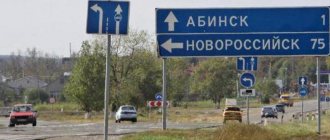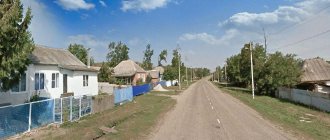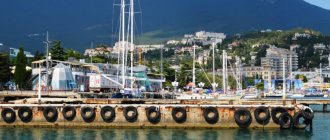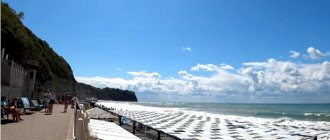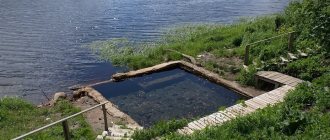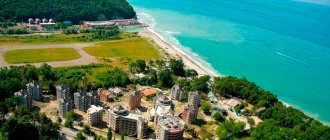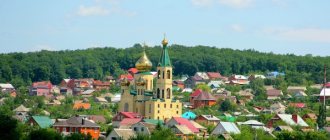Historical sights of Krasnodar
Monument to Catherine II
The majestic monument erected in honor of the beautiful Catherine II has gone through a lot. The creator of the first sculpture in 1907 was the famous sculptor Mikhail Mikeshin. The composition of the monument represents the empress standing proudly at the top and firmly holding a scepter in one hand and an orb in the other. Below are Prince Potemkin and three atamans of the Cossack army, behind them you can see a blind kobzar. After the revolution, the monument was destroyed by the Bolsheviks and sent for melting down. But in 2006, the monument was restored again.
Chistyakovskaya Grove
One of the oldest and largest city parks today delights residents and guests of Krasnodar with its attractions, well-groomed alleys and an open-air cinema. The park received its name in honor of the mayor Gavrila Chistyakov. He himself, together with schoolchildren, planted the first trees in Chistyakovskaya Grove - oaks, ash, pine and birch. Green spaces were seriously damaged during the Civil War. Today Chistyakovskaya Grove is proud to be the best park in Russia.
Memorial to the victims of fascist terror
The monument, calling to never forget your history, is located on the territory of the Chistyakovskaya Grove. In the middle of the composition stands an old partisan, meeting his death with his head held high, and next to him are young men, a woman sobbing on her knees and a little girl saying goodbye to her mother in the last minutes before the terrible end. On a slab of white marble are written the screaming words: “Remember, remember, remember, people. The killer’s name is fascism!”
Botanical Garden named after Professor I. S. Kosenko
Today, this landmark of Krasnodar is a wonderful place for walking. Its clean alleys are visited with pleasure by both modern youth and older people. The first plantings included in the list of unique plants of Eurasia and America were made in 1959 by Ivan Sergeevich Kosenko. The garden also contains various species of birds, some of which are listed in the Red Book. Until 2007 it belonged to the university, but then it was opened to everyone.
Shukhov Tower
The structure is a steel water tower built in 1935. It received its name in honor of the Soviet engineer Vladimir Grigorievich Shukhov. Today the tower is not used for its intended purpose; it is only a historical landmark of Krasnodar.
Or maybe the sights of Kazan or Minsk?
St. Catherine's Cathedral
After a train accident, in which members of the royal family of Alexander III miraculously survived, they decided to build a five-domed cathedral with seven thrones. Hard times came for him after the revolution. In 1922, the cathedral was looted and they were preparing to blow it up, citing a shortage of bricks. Ivan Malgerb, the architect of this Krasnodar landmark, proved to the authorities that destroying the cathedral would be wrong and pointless. In 2014, St. Catherine's Cathedral celebrated its hundredth birthday.
Alexander Nevsky Cathedral
The Alexander Nevsky Temple has its own unique and inimitable history. It took 19 years to build it, but, unfortunately, we can only see its beauty and splendor in old photographs and hear in the stories of local residents. The main reason for its demolition in May 1932 was the brutal struggle against religion. In 2003, the famous Russian architect Valery Timofeevich Goloverov began to recreate the Krasnodar Cathedral. Today's temple is very similar to its predecessor.
Monument to the Kuban Cossacks
The government and residents of Krasnodar do not forget about who they owe their city to. As you know, Ekaterinodar was founded by the Cossacks in 1792, and 213 years later, in 2005, a monument was unveiled on Krasnaya Street. The bronze monument is represented by a Kuban Cossack on his faithful war horse. He has a hat on his head and a dagger behind his back. The prototype of the work of the talented sculptor Alexander Apollonov is the Cossack ataman and brigadier of the Russian army - Anton Golovaty.
Sculpture “Cossacks writing a letter to the Turkish Sultan”
Art lovers will probably ask themselves: “What to see in Krasnodar?” They will receive their answer in the city center, having discovered a monument created based on the painting “The Cossacks Write a Letter to the Turkish Sultan” by the famous artist I. E. Repin. Back in 1888, Ilya Efimovich visited Yekaterinograd to find sources of inspiration for his new painting. The artist headed for the Pashkovskaya station, where the great-grandchildren of the Zaporozhye Cossacks lived. There, immersed in the atmosphere, he made sketches for his work.
Historical and Archaeological Museum-Reserve named after E. D. Felitsyn
The museum boasts a huge number of exhibits stored within its walls - more than 428 thousand! Evgeny Dmitrievich Felitsyn, a Russian scientist historian and archaeologist, gave his name to the building, which he founded in 1879. At first it was the Military Ethnographic and Natural History Museum, which received official status only almost 30 years after its founding, in 1907. During the Great Patriotic War, very little is known about the activities of the museum, but after the end of the war it again opened its doors to visitors.
We also have sights of Moscow and Yekaterinburg
Making monuments
How to choose and order a monument
In order not to make a mistake when choosing a monument for your grave, you need to have a clear idea of the product. Our workshop will help you with this: we will present catalogs of finished works, tell you about the advantages of different materials, and discuss personal wishes. We will prepare and approve a standard project or an original, original one. You can order from us:
- single, double, family tombstones;
- children's monuments;
- stands for candles, treats, flowers;
- fences, crosses, benches and tables;
- engraving works (epitaphs, icons);
- products depicting a portrait of the deceased;
- memorial buildings.
You can ask the craftsman the desired size of the stele, cabinet, tomb; direction - vertical or horizontal. We make memorials of various configurations. You can order from us the production of a simple monument of a geometric shape or a figured one with carved elements. When choosing, take into account the personality characteristics of the deceased. For example, a modest person during his lifetime would be better symbolized by a strict, laconic product. If the deceased was a creative person or you like unusual solutions, choose a curly one with an exclusive design. A universal solution would be a combined memorial made from different types of stone. We work with marble, granite and crimson quartz and are ready to offer you beautiful combinations. All materials are certified and ultrasonic tested. Products are treated with protective compounds against corrosion, mildew and mold, which allows them to preserve their appearance for several decades.
Our workshop can produce a tombstone with the desired religious symbolism. We will decorate the tombstone with the faces of saints, frescoes, and quotes. We will depict decorative elements, ornaments, animals, flowers. We approach each client carefully and responsibly, take into account all wishes, and pay attention to detail.
Prices for monuments:
| Stele dimensions | Monument price | Portrait+inscription | Installation |
| 80x40x8 cm. | 12,000 rub. | 5,000 rub. | 3,000 rub. |
| 100x50x8 cm. | 25,000 rub. | 5,000 rub. | RUB 3,500 |
| 100x60x8 cm. | 18,000 rub. | 6,000 rub. | 4,000 rub. |
| 120x60x8 cm. | 33,000 rub. | 6,000 rub. | 4,500 rub. |
| 120x60x10 cm. | 23,000 rub. | 6,000 rub. | RUB 5,500 |
| 120x70x8 cm. | 37,000 rub. | 6,000 rub. | RUB 5,500 |
| 120x70x10 cm. | 26,000 rub. | 6,000 rub. | 6,000 rub. |
| 130x70x8 cm. | 40,000 rub. | 6,000 rub. | 6,000 rub. |
| 130x70x10 cm. | 45,000 rub. | 6,000 rub. | 6,500 rub. |
| 140x60x10 cm. | RUB 29,500 | 8,000 rub. | 6,500 rub. |
| 140x70x10 cm. | RUB 38,500 | 9,000 rub. | 7,000 rub. |
| 150x70x10 cm. | 50,000 rub. | 9,000 rub. | 7,000 rub. |
* check the exact price by phone
Ordering a monument for a grave in the Monument workshop
- Free visit of a specialist to take measurements and provide recommendations.
- Individual approach to each client. We will help you adequately convey and perpetuate the image of the deceased person, the way you want it.
- Fixed cost. An agreement is concluded between the client and the company, which specifies the price and terms of work. The conditions do not change during the work process.
- High quality. We make tombstones from natural stone that look natural, are not destroyed by external influences and do not wear out.
- Possibility to receive a custom-made monument according to an author’s design, including delivery and installation.
- Confidence in the quality of services provided. We have been working for more than 20 years. During this time, we gained vast experience and customer trust.
- Assistance in improving the grave (one-time or ongoing maintenance).
Our workshop guarantees that the product will be manufactured on time and comply with the design project. To calculate your order or get advice, use the site’s contacts. If it is convenient for you, the manager will come with samples of materials to your home or office.
History of the monument to Catherine the Second in Krasnodar
The idea of creating a monument dedicated to Catherine II arose at the end of the 20th century. The sculpture was dedicated to the 100th anniversary of the resettlement of the Black Sea army to the Kuban lands.
The famous sculptor M. O. Mikeshin began working on the monument project. At the beginning of 1896, the artist died, leaving only sketches for the future monument. This unfinished project was presented at the Grand Palace of St. Petersburg by the wife of the late sculptor. The monument project was approved and construction work began.
© Anna Kudryavtseva
The construction of the monument to Catherine II in Krasnodar was carried out under the leadership of B.V. Edwards. In September 1896 the first stone was laid. The construction work itself lasted 11 years. The grand opening of the monument took place in May 1907.
The monument did not stand for long. With the advent of Soviet power, the Kuban Revolutionary Committee in 1920 decided to dismantle the monument to Catherine the Second. In 1931, the dismantled sculpture was melted down.
They started talking about restoring the monument in 2002 at the instigation of the governor of Krasnodar. The project to restore the monument was led by A. A. Apollonov. To implement the plan, archival documents with drawings, photographs and sketches of M. O. Mikeshin were collected.
© Anna Kudryavtseva
In September 2006, the grand opening of the revived monument to Catherine the Second took place. It was installed in its original place, where it stood before dismantling.
Main characteristics of the monument
The entire composition is created from a collection of different characters. In the center of the monument, the empress stands on a pedestal with a scepter and orb in her hands. Catherine II is depicted in the royal robe. In front of it, in the central part of the monument, is the Charter of 1792.
© Anna Kudryavtseva
On the left hand of the Empress is the figure of Prince Potemkin. He is depicted against the background of a flag and military insignia. On the right hand are the three first leaders of the Black Sea Cossack army: Anton Golovaty, Sidor Bely, Zakhary Chepega. Along with these figures, in the lower part of the monument there is a sculpture of a kobzar with a guide. Here is also a list of victories that the country won with the support of the Kuban Cossacks.
The monument to Catherine the Second is based on several different types of metal: bronze, cast iron, aluminum, gold leaf. The height of the monument is almost 14 meters, and the width of the entire ensemble is 16 meters. The statue of Catherine the Second weighs 3 tons and is 4 meters high.
© Anna Kudryavtseva
Monuments and memorials | Krasnodar region. Part 1
Monuments of the Abinsk region
Abinsk. Monument to the Sorrowful Mother at the Old Cemetery, erected in 1946 on a mass grave in which 2,312 Soviet soldiers who died in the battles for the village were buried.
Abinsk. The monument to the Marines at the Old Cemetery was erected on the mass grave of military sailors who died in the battles near the village of Abinskaya. The words are engraved on the plaque: “Here are buried 41 soldiers of the 83rd Twice Red Banner Order of Suvorov, Novorossiysk-Danube Separate Rifle Brigade of the Marine Corps. Those killed in battles with the Nazis near the village of Abinskaya in September-October 1942. Eternal glory to the fallen heroes."
The central obelisk of the park.
Cenotaph.
Mass graves of 522 soldiers.
Memorial sign to soldiers of 14 divisions.
Memorial sign to home front workers and the Avenue of Heroes.
BM-13 "Katyusha".
Monument tank IS-3m.
Abinsk. The memorial complex in Victory Park was opened on March 23, 1968. It includes a monument to the soldiers who died during the liberation of Abinsk, an obelisk and the Eternal Flame at its foot. The names of the army and troops that defended the village in 1942-1943 are carved on the memorial slabs of the pedestal. In 1973, an IS-3m tank and a BM-13 missile launcher were installed. In 1983, a memorial sign to the Unknown Soldier was installed on the territory of the memorial.
Abinsk. Monument to pilots at the jump airfield.
Abinsk. A memorial sign in Gorky Ravine at the site of the execution of 273 civilians.
General view of the mass grave.
Monument at the mass grave.
Abinsk. Monument at cemetery No. 3, erected on a mass grave in which 21 soldiers are buried.
Abinsk. Tombstones at cemetery No. 3, installed on mass graves in which 64 soldiers are buried.
Abinsk. Monument at 60 Mira Street, erected in memory of the fallen fellow countrymen who died during the war.
Abinsk. A memorial sign to fallen employees installed on the territory of the cannery.
Abinsk. Monument to the fallen employees of the DOK, installed at 16 Vokzalnaya Street.
Abinsk. Memorial sign to the crew of the B-3 Boston bomber that died on January 28, 1943.
Abinsk. A monument on the territory of the fruit farm, erected on the mass grave of Soviet soldiers.
Abinsk. Monument in the cemetery, erected on the mass grave of Soviet soldiers.
X. Aushed Abinsk district. A monument erected on a mass grave in which 23 Soviet soldiers were buried.
Akhtyrsky village, Abinsk district. A memorial in the cemetery, installed near the mass graves in which 474 Soviet soldiers are buried.
Akhtyrsky village, Abinsk district. Monument in honor of the fire fighters who died during the war.
Akhtyrsky village, Abinsk district. A monument erected on a mass grave in which 5 Soviet soldiers of the 16th separate rifle brigade who died in 1943 are buried.
Akhtyrsky village, Abinsk district. A memorial sign at the site of the “Whirlwind” partisan detachment.
With. Varnavinskoye, Abinsk district. The monument on Krasnaya Street was erected on the mass grave of Soviet soldiers who died during the war.
X. Krasnooktyabrsky, Abinsk district. Monument to fellow countrymen who died during the war.
X. Leninsky Abinsk district. A monument on the territory of school No. 34, erected on the mass grave of Soviet soldiers.
X. Leninsky Abinsk district. A monument in the cemetery erected on the grave of pilot I.F. Volost.
X. Leninsky Abinsk district. Monument at 69a Kirova Street, erected on the mass grave of Soviet soldiers.
General view of the memorial.
Bust of Hero of the Soviet Union K.F. Kovalev.
st-tsa. Mingrelskaya, Abinsk district. Memorial to fellow countrymen who died during the war and busts of Heroes of the Soviet Union.
st-tsa. Mingrelskaya, Abinsk district. A monument erected on a mass grave in which 120 Soviet soldiers were buried.
n. New Abinsk district. Mass grave of Soviet soldiers in the forest.
X. Olginsky, Abinsk district. Monuments along Kubanskaya Street to fellow countrymen and Soviet soldiers who died during the war.
X. Pervomaisky, Abinsk district. Monument to fallen soldiers during the war.
Proletary village, Abinsk district. A monument erected on a mass grave in which 24 Soviet soldiers were buried.
X. Garden, Abinsk district. A monument erected on a mass grave in which 3 Soviet soldiers were buried.
Sinegorsk village, Abinsk district. A monument on the territory of the clinical leper colony, erected on the mass grave of Soviet soldiers.
Sinegorsk village, Abinsk district. Memorial sign at the site of the death of pilot Lieutenant P.S. Sergeeva.
Sinegorsk village, Abinsk district. Monument to fellow countrymen who did not return from the war.
village of Sosnovaya Roshcha, Abinsk district. Monument to Soviet soldiers who died during the war.
st-tsa. Fedorovskaya, Abinsk district. Memorial at school No. 12, installed on the mass grave of Soviet soldiers.
X. Khabl, Abinsk district. A monument erected on a mass grave in which 39 Soviet soldiers were buried.
Share to:
Pages: 1
